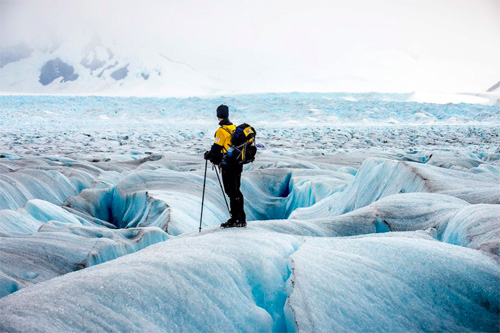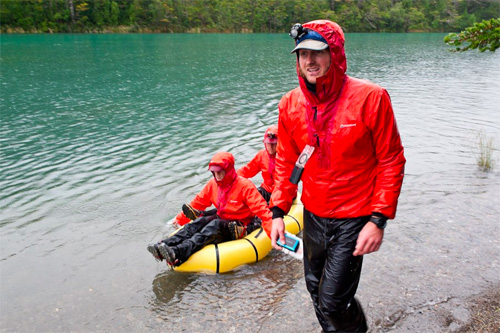Over the course of 10 days of continuous adventure racing through 700km of Patagonian wilderness, Team GearJunkie–YogaSlackers flat-out suffered. Hard. This video and race report from the team of last week’s Patagonian Expedition Race is painful to watch and hard to read. Wind, snow, bushwhacking, fjord crossings and bad stomachs pushed the team to the limit. Through it all these four masters of suffering took 3rd place in the “Race at the End of the World.”
—Editor Stephen Regenold completed the Patagonian Expedition Race in 2010 and 2011.
Post-race report; Daniel Staudigel, 02/25/13 — There has to be a “world’s hardest race” somewhere, right? I’m pretty sure the Patagonian Expedition Race takes that title.
In early February, we arrived in Punta Arenas, Chile, with strong expectations as a team. It was our fourth time coming to the country to compete. We had been training intensely for months, and we arrived confident and feeling strong.
Fate had other plans. Hours before the race, Paul became violently ill with what we hoped was just pre-race anxiety. Then the start. Having purged every calorie and ounce of free water from his body, Paul’s normally furious cycling pace slowed to a crawl, punctuated by frequent trips into the bushes. I guess it wasn’t just nerves.
Even given Paul’s condition, we finished the first stage in 4th place. We rushed through a transition and hustled to make it to the glacier — the crown jewel of this year’s race. On the way there, we passed Team Berghaus, putting us in 3rd. The glacier was spectacular. Perfect weather allowed us to make an easy crossing. The race director’s recommended route kept us away from the more treacherous terrain. We enjoyed the challenge of avoiding crevasses and the surreal and eerie patterns in the ice.

After coming down off the glacier, we planned to cross the adjoining lake by packraft. By the time we got there it was almost night, and we had our first heated conflict as a team. Jason, the team captain, wanted to go forward with the crossing, but the rest of us were hesitant because of the bitter cold water and threatening weather. When Jason was overruled, we had to get back to the recommended route – by the time we did this it was deep in the night, and we had wasted hours on the gambit.
Bushwhacking the next day, we realized how slow backcountry travel can be. We could have saved hours if we had waited for morning and crossed the lake at first light. Live and learn. We wouldn’t make the same mistake again: during the rest of the stage we spent almost six hours in the packrafts crossing lakes and fjords, saving us many kilometers of agonizing bushwhacking.
We would learn later that by the end of the second stage, the race was essentially over. We were in third place with minimal chance of passing the Japanese team, and zero chance of being passed. We completed a few more quick legs before this fact sank in. During these stages it became clear that Paul was finally feeling much better. Unfortunately, I picked up where he left off. During our third biking stage I had to stop every 20 minutes to run to the bushes. My strength wouldn’t last long unless I got my gut under control. Try as I might with Imodium and a simple diet of mostly Tailwind, it took almost two days for me to return to normal.
Starting the second stage, Chelsey was racked by a viciously painful fungal infection on the sole of her foot, a twisted ankle, and slowly mounting tendonitis in her shin. We tried to deal with each of these problems individually, but her eyes still gleamed with barely-controlled pain. We ended up getting her through this second trek with heavy painkillers, which was something none of us was particularly comfortable with.

For those of us not in a drug-induced haze, the second trek was brutal. It left each of us wondering what we were still doing out there. Wind and weather has a way of wearing down sanity. By the end of this trek, there wasn’t much of it left.
We started the fourth biking stage, the longest stage by distance, with a profound lack of excitement. The second trek had sapped us dry, and we moved forward purely by momentum. The going got easier and easier, and our spirits raised in equal measure.
We sailed downhill and downwind until the route took a turn. Gorgeous sights and unique terrain were a backdrop for increasingly difficult team dynamics. Toward the end of this ride, wind became the enemy, the person in the room screaming senselessly, drowning out reason and thinning tempers. Shouting over the wind, through tears and anger, we resolved to keep going and try our best to finish the journey under our own power, despite the fact that it would not change our position.
We arrived at the transition frozen by hail and freezing rain, battered by hours crawling against the headwind. Stjepan, the race director, offered us a short-course option that allowed us to finish under our own power without forcing Chelsey to hike the full 90km trek in agony. We had to wait for a day, though, to allow Team East Wind to cross the finish line in the position they earned.









